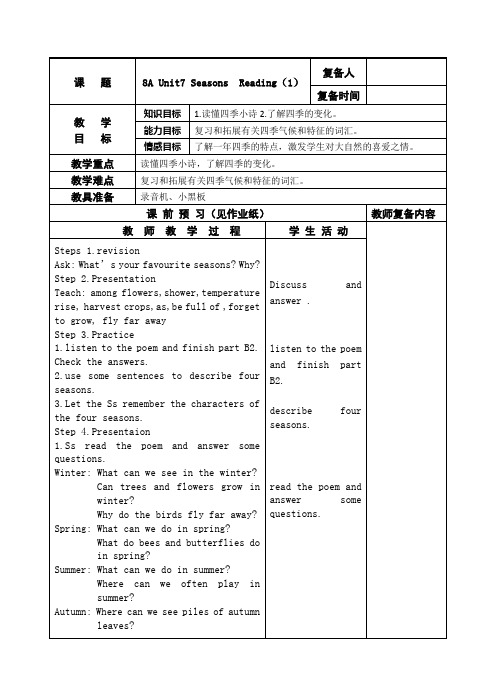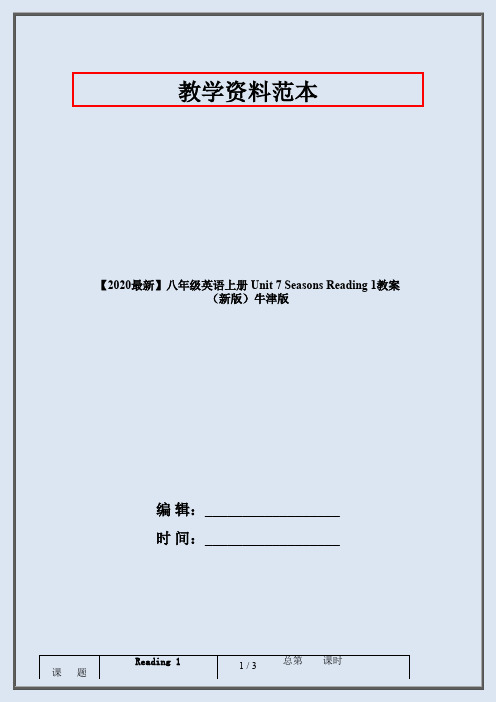八年级英语上册 Unit 7 Seasons Reading I教案 (新版)牛津版
- 格式:doc
- 大小:29.00 KB
- 文档页数:3

牛津译林版英语八年级上册《Unit 7 Seasons Reading 1 A poem about seasons》教学设计6一. 教材分析本课选自牛津译林版英语八年级上册《Unit 7 Seasons Reading 1 A poem about seasons》,主要介绍四季的特点。
文章以诗歌的形式,生动描绘了春夏秋冬的景色和活动,让学生在欣赏诗歌的同时,了解四季的变化。
通过本课的学习,学生能够提高阅读理解能力,学习描述四季的词汇和句子结构,并能运用所学知识进行表达。
二. 学情分析八年级的学生已经具备一定的英语基础,对于四季的概念也有清晰的认识。
但学生在描述四季时,可能会缺乏具体的词汇和句式。
因此,在教学过程中,教师需要帮助学生拓展四季相关的词汇,并提供适当的句式结构,以便学生能够更好地表达自己的观点。
三. 教学目标1.知识目标:–能够理解诗歌中描述四季的词汇和句子结构。
–能够运用所学知识,描述四季的特点。
2.能力目标:–提高学生的阅读理解能力。
–提高学生的口语表达和写作能力。
3.情感目标:–培养学生对大自然的热爱,增强环保意识。
四. 教学重难点•掌握描述四季的词汇和句子结构。
•能够阅读并理解诗歌内容。
•运用所学知识,进行口语表达和写作。
五. 教学方法1.情境教学法:通过设置四季的场景,让学生在真实的情境中学习词汇和句子。
2.互动式教学法:引导学生进行小组讨论,提高学生的参与度和积极性。
3.任务型教学法:通过完成具体任务,培养学生运用英语进行交流的能力。
六. 教学准备1.教师准备:–熟悉教材内容,明确教学目标。
–准备相关的四季图片、视频等教学资源。
2.学生准备:–预习教材内容,了解四季的基本概念。
七. 教学过程1.导入(5分钟)教师通过展示四季的图片或视频,引导学生谈论四季的变化,激发学生的学习兴趣。
2.呈现(10分钟)教师带领学生一起阅读诗歌,引导学生关注描述四季的词汇和句子结构。
在阅读过程中,教师适时提问,帮助学生理解诗歌内容。


教学资料范本【2020最新】八年级英语上册 Unit 7 Seasons Reading 1教案(新版)牛津版编辑:__________________时间:__________________Unit 7 seasonsTeachingaims1. To guess general meanings from keywords and context2. To skim text for overall meanings and scan for detailsTeaching focus To identify specific information about different people form the poem Difficultpoints To use words to describe the change of the four seasonsTeachingmethodTask-basedapproach Teaching procedures The secondpreparinglessonsStep 1 Revision. What ’s your favourite season? Why? I like winter . It often snows in winter. It ’s the best time to play with snow. Step 2 Presentation1. T: Spring is the best season of the year. It ’swarm and windy. It ’s the best time to fly kites. Bees and butterflies play among flowers. 2.3. Summer is hot ,but we can enjoy a long summerholiday. What can we do in summer? We can go swimming. We can eat an ice cream. There are also quiet streams, trees and shade. I like chatting or re ading in the middle of the day. The temperaturerises quickly at that time.4. What colour are the leaves? They are yellow, red,golden and brown. In autumn, the leaves turn brown. they fall into piles upon the ground. It ’s the best time for farmers to harvest crops.5. ’s cold in winter. Sometimes it ’s snowy. theground is covered with snow. Birds fly far away. Step3DrillsNow please open your books and turn to page 83.Look at Part B2.We are going to listen to the poem. Write down the correct seasons in the blanks. Then match each season with the description in the poem.1It ’s spring. what a perfect time to fly a kite! Bees and butterflies play among flowers.备课时间上课时间 课 时Period 2教 具A recorder2 It’s autumn. Brown leaves fall on the ground.Farmers harvest crops.3It’s winter. Winter days are full of snow. Birds fly far away.4It’s summer. There are quiet streams, trees and shade. We can eat ice cream.Step4Practice1What can we see in winter2Can trees and flowers grow in winter?3Why do the birds fly far away?1What can we do in spring?2what do bees and butterflies do in sping?1What can we do in summer?2where can we often play in summer?1Where can we see piles of autumn leaves?2What are the farmers busy doing in autumn?Read the poem again and find the rhyming words.Read the poem again ,and then disc uss and find the sentences in which the writer uses personification.Step5 ActivitiesPlease repeat the po em after the tape.Pay attentio n t o your pronunciation and intonation.Pl ease read the poem together and express y our feelings about each season.I’m going to divide you into four groups.Each group will read one of the seasons.Step 6HomeworkMaster the important words phrases and sentences.Recite the poemTeachingnotes。
![[推荐学习]八年级英语上册 Unit 7 Seasons Reading教案 (新版)牛津版](https://img.taocdn.com/s1/m/81f57004915f804d2b16c166.png)

牛津译林版八年级上册Unit 7《Seasons》(Reading 1)说课稿一. 教材分析《Seasons》(Reading 1)选自牛津译林版八年级上册,主要讲述了四个季节的特点以及人们在不同季节里的活动。
文章内容丰富,语言简练,贴近生活,易于学生理解和接受。
通过学习本篇文章,学生可以掌握季节的相关词汇和表达方式,提高阅读理解能力,同时也能培养他们对生活的热爱和观察力。
二. 学情分析八年级的学生已具有一定的英语基础,对日常生活中的事物有一定的了解。
但他们在阅读理解方面还需进一步提高,特别是对于长篇阅读材料的理解和分析能力。
此外,学生们的思维方式和表达手段较为单一,需要通过本节课的学习,激发他们的创新意识和表达能力。
三. 说教学目标1.知识目标:学生能够掌握季节的相关词汇和表达方式,了解四个季节的特点以及人们在不同季节里的活动。
2.能力目标:学生能够提高阅读理解能力,学会从文章中获取有用信息,并进行简单的信息整合和表达。
3.情感目标:通过学习本篇文章,培养学生对生活的热爱和观察力,激发他们积极向上的生活态度。
四. 说教学重难点1.重点:季节相关词汇的掌握和运用,以及阅读理解能力的提高。
2.难点:对文章中长句和复杂句型的理解,以及如何运用所学知识进行创新表达。
五. 说教学方法与手段本节课采用任务型教学法,以学生为主体,教师为主导。
通过设置各种任务,激发学生的学习兴趣和积极性,培养他们的自主学习能力。
同时,运用多媒体教学手段,丰富教学内容,提高学生的学习效果。
六. 说教学过程1.导入:教师通过提问方式引导学生谈论季节,激发学生的学习兴趣。
2.阅读理解:学生自主阅读文章,完成相关练习,教师进行讲解和解答。
3.词汇学习:教师引导学生学习文章中的季节词汇,并进行实际运用。
4.任务型活动:学生分组讨论,根据文章内容创作关于季节的短文。
5.展示与评价:各小组展示自己的作品,全班同学进行评价和投票。
6.总结与反思:教师对课堂内容进行总结,学生分享自己的学习收获和感悟。

牛津译林版八年级上册Unit 7《Seasons》(Reading 1)教学设计一. 教材分析《Seasons》是一篇关于四季的文章,介绍了春夏秋冬的特点以及人们在不同季节里的活动。
文章内容丰富,语言简单易懂,适合八年级学生学习。
本篇文章旨在让学生了解和掌握季节相关的词汇和表达方式,提高学生的阅读理解能力,培养学生用英语进行交流的能力。
二. 学情分析八年级的学生已经掌握了基本的英语语法和词汇,具备一定的阅读理解能力。
但是,学生在学习过程中仍然存在以下问题:1. 对季节词汇的掌握不够熟练;2. 英语口语表达能力较弱;3. 学习积极性有待提高。
三. 教学目标1.知识目标:让学生掌握与季节相关的词汇和表达方式,如spring,summer, autumn, winter, bloom, fade, etc.;2.能力目标:提高学生的阅读理解能力,使学生能够熟练运用所学知识进行口语交流;3.情感目标:培养学生热爱生活、珍惜时间的积极情感。
四. 教学重难点1.重点:季节词汇和与季节相关的表达方式;2.难点:正确运用季节词汇进行口语交流。
五. 教学方法1.情境教学法:通过设定现实情境,让学生在实际语境中学习和运用季节词汇;2.交际教学法:采用两人一组或小组合作的形式,让学生进行实际的语言交流;3.任务型教学法:通过完成各种任务,激发学生的学习兴趣,提高学生的参与度。
六. 教学准备1.准备四季的图片,用于展示和引导学生讨论;2.准备季节词汇卡片,用于操练和巩固;3.准备与季节相关的活动材料,如春游、夏季游泳等,用于拓展和巩固。
七. 教学过程1.导入(5分钟)a.向学生问候,了解学生上一节课的学习情况;b.引导学生谈论各自喜欢的季节,并简要说明原因。
2.呈现(10分钟)a.向学生展示四季的图片,引导学生用英语描述图片内容;b.呈现季节词汇卡片,让学生朗读并模仿发音;c.教师用英语简要介绍文章内容,激发学生的阅读兴趣。
Unit 7 SeasonsReading (I)I. Teaching aims and learning objectivesBy the end of the lesson, students should:1. Learn to read and feel the beauty of the poem.2. Learn to tell the rhythm.3. Learn to improve the ability of appreciating a poem.II. Teaching contents1. New words and phrases: shower, upon, as, temperature, drop, butterfly, memory,stream, shade, pile, harvest, crop, be full of, forget to grow,fly, brown, fall into piles upon the ground, harvest crop 2. Sentences: What a perfect time to fly a kite!Farmers work to harvest crops, as the days are shorter and temperature drops.III. Focus of the lesson and predicted area of difficultyUnderstand the words related to the weather in four seasons.Understand the rhymes and the rhyme styles.IV. Teaching proceduresStep 1 Lead-in1. Discuss: What is a poem?2. Give explanations of what a poem is by using a poem as an example.【设计意图】用诗歌导入,生动形象,引发学生阅读诗歌的兴趣。
Unit 7SeasonsWele to the unitTeaching aims:Knowledge Objective:Words: rainy snowyPhrases: look cool with nothing onSentences: Which season do you like best?It’s the best time to play football outside.Which is your favourite season?Ability Objective:To learn to describe weather and seasonsTo learn to talk about your favourite seasons EmotionObjective:学习使用不同的形容词来谈论自己喜欢的季节,热爱自然,热爱生活。
【学习重、难点】Difficult points:1.掌握本课四会单词与短语,并能熟练运用。
2.谈论喜欢的季节Teaching steps:Step 1. Presentation1. Show some pictures to learn some words .2. Then read aloud the new words.foggy, rainy, snowyStep 2.Do some exercises.1. Do Part A on page 81.2. Check the answers.Step 3. Listen and answer1. Listen to the tape and answer the follow questions.1) What does Eddie ask hobo to do?2) Is it cold today?3) Does hobo think Eddie look cool?2. Read the dialogue after the recorder.3. Read the dialogue in pairs.4. Act it out.Step 4. Listening.1. Listen to part B and answer the following question.1) Which season does Simon like best?2) What’s the weather like in Autumn?3) What can Amy do in summer?2. Read after the recorder.3. Pratice in pairs.4. Act it out.Step 5. Explanation1. Bring me my clothes, Hobo.bring 带来take 带走e.g. Please bring me my coat.Take your book home after school2. You’ll look cool and feel cool with nothing on!look cool 看起来酷3. Which season do you like best, Simon?Which is your favourite season?like … best / favourite 最喜欢……e.g. I like spring bestMy favourite season is spring.Step 6. Exercises一、根据汉语提示或所给词的正确形式填空。
牛津译林版英语八上Unit 7《Seasons》(Welcome to the unit)教学设计一. 教材分析牛津译林版英语八上Unit 7《Seasons》(Welcome to the unit)主要介绍四季的特点以及人们在不同季节的活动。
本节课通过描述不同季节的天气、景色和活动,让学生学会表达季节变化和规划四季活动。
教材内容丰富,贴近生活,有利于激发学生的学习兴趣和参与欲望。
二. 学情分析学生在进入八年级时,已经掌握了基本的英语语法和词汇,具备一定的听说读写能力。
他们对季节变化有一定的认知,但可能缺乏对四季活动的深入了解。
因此,在教学过程中,教师需要关注学生的个体差异,充分调动他们的积极性,引导他们主动参与课堂活动。
三. 教学目标1.知识目标:学生能够掌握描述四季特点和活动的词汇和句型,学会表达季节变化和规划四季活动。
2.能力目标:学生能够在真实情境中运用所学语言进行交流,提高听说读写能力。
3.情感目标:学生能够增强对季节变化的认知,培养热爱生活、积极参与户外活动的意识。
四. 教学重难点1.重点:描述四季特点和活动的词汇、句型。
2.难点:如何运用所学语言真实交流,表达季节变化和规划四季活动。
五. 教学方法1.任务型教学法:通过设计具有实际意义的任务,引导学生参与课堂活动,提高他们的语言运用能力。
2.情境教学法:创设真实情境,让学生在情境中感受季节变化,增强对四季活动的认知。
3.互动式教学法:鼓励学生积极参与课堂互动,提高他们的听说读写能力。
六. 教学准备1.准备四季图片、视频等教学资源。
2.设计相关任务和活动。
3.准备板书所需的黑板和教具。
七. 教学过程1.导入(5分钟)利用图片、视频等教学资源,引导学生谈论四季变化,激发学生的学习兴趣。
2.呈现(10分钟)展示四季图片,引导学生用英语描述四季特点。
教师适时引入新词汇和句型,如“spring is a beautiful season with warm weather and blooming flowers.”3.操练(10分钟)分组进行角色扮演,让学生模拟在不同季节的活动。
Unit 7 Seasons
Reading (I)
I. Teaching aims and learning objectives
By the end of the lesson, students should:
1. Learn to read and feel the beauty of the poem.
2. Learn to tell the rhythm.
3. Learn to improve the ability of appreciating a poem.
II. Teaching contents
1. New words and phrases: shower, upon, as, temperature, drop, butterfly, memory,
stream, shade, pile, harvest, crop, be full of, forget to grow,
fly, brown, fall into piles upon the ground, harvest crop 2. Sentences: What a perfect time to fly a kite!
Farmers work to harvest crops, as the days are shorter and temperature drops.
III. Focus of the lesson and predicted area of difficulty
Understand the words related to the weather in four seasons.
Understand the rhymes and the rhyme styles.
IV. Teaching procedures
Step 1 Lead-in
1. Discuss: What is a poem?
2. Give explanations of what a poem is by using a poem as an example.
【设计意图】用诗歌导入,生动形象,引发学生阅读诗歌的兴趣。
Step 2 Presentation
1.First reading
(1) Read the poem by themselves, find its theme and feel its tone.
(2) Answer the following questions.
Is it telling a story? What is it about?
Who is speaking in the poem?
How do you feel after reading it? Sad? Cheerful/light? Excited? Stressed (压抑)?
2.Second reading
(1) Ask students to read the poem by following the tape and try to find out the
new words that stop them from understanding the poem.
(2) Explain the new words with pictures.
3.Third reading
(1) Explain what poem is by quoting Allan Poe.
(2) Get students to read the poem again and try to learn the rhymes and the feet
of it. Then go through each part of the poem and figure out the rhymes and the feet of the poem.
a. Find the rhymes. … rhymes with …
b. Find the rhyme style: aabb, abab, aaba, abaa
4.Detail reading
(1) About winter
a. Ask students two questions lead to the season part.
What can you think of when winter comes?
What do you like to do in winter?
b. Get students to close their eyes and draw a picture of winter in their mind
while listening.
(2) About spring
a. Encourage students to read the spring part aloud and catch the key word
that the writer uses to describe spring.
b. Require students to further read spring part to get detailed information in it.
c. Make students tell the feelings of spring after reading it.
(3) About summer
a. Organize a group discussion for students to share their own summer
stories.
b. Ask students to read the summer part and find out the key word that the
writer uses to describe summer.
c. Give students some more time to read it carefully again and find out what
the writer writes about in his sweet summer.
d. Draw a conclusion and make a comparison between the writer’s and
students’ summer.
(4) About autumn
a. Manage a discussion -- What is autumn like in your mind? Students discuss
in groups
and share their thoughts.
b. Ask them to read the autumn part and discover what the writer’s autumn is like.
c. Get students to fill in the form after reading this part again to get
the detailed information.
d. Encourage students to express their understanding of the last two lines
in the autumn part and evaluate their answers in time.
【设计意图】引导学生感受诗歌中优美的韵律,找出韵脚。
享受审美情趣,提高审美能力。
最后带领学生分步阅读小诗中的每个段落,通过设置问题启发学生思考,联想,引导学生逐步掌握每个段落的细节,体会作者诗歌中传神的字词和诗中所反映的意境,感悟诗人写诗时的心情,领悟诗人的意图,达到欣赏的目的。
Step 3 Practice
1. A reading competition
Organize a reading competition and each group should recommend a student to read the poem with emotion after practicing in groups. And other group members give evaluation and choose the best voice of the class.
2. Get students to read the poem by heart and tell which line or which part they like best and why they like it.
3. Give a summary
T: Wishing you each season filled with joy and fun!
【设计意图】鼓励学生有感情地朗读诗歌,通过朗读加深对诗歌内容和意境的体会,并结合作者的描述和感情畅谈个人对四季的偏爱,引导学生珍惜时光、热爱生活。
V. Homework
1. Read the poem with emotion after class and translate the poem into Chinese. (Try to make your translation beautiful and poetic.)
2. Choose your best season in the poem to write a short passage.。